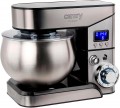Number of speeds
The number of fixed speeds of rotation of the attachments provided in the design of the food processor. The more of them, the more accurately you can choose the required speed for each specific mode of operation. It is worth noting that some devices do not have fixed speeds — the control is carried out smoothly (see Stepless speed controller)
Pulse mode
The ability to operate the food processor in
pulsed mode, when the motor does not rotate constantly, but with pauses. This mode is particularly useful when processing hard foods, such as frozen fruits and vegetables, to ensure efficiency while reducing engine load.
Body material
The main material used for the body of the unit.
—
Plastic. The main advantage of plastic is the relatively low cost. In addition, this material can have almost any colour, including quite bright ones. In terms of strength and reliability, the plastic is inferior to metal, but this difference does not play a special role in normal use, it becomes noticeable only in various emergency situations (during falls, overheating, etc.). Also, plastic bodies are relatively easy to scratch, but this point mainly affects the appearance of the unit and does not affect the functionality. In light of all this, only plastic is the most popular material for the bodies of modern food processors.
—
Metal. Metal bodies are distinguished by their solid appearance and high strength. On the other hand, this material is noticeably more expensive than plastic, and therefore is less common — mainly in middle and high class food processors.
Section for cord
A special section in the body of the device for storing the power cord. Often such sections are also come with devices for uniform winding of the wire, which prevents bending and possible fractures.
The cord section is especially useful if the food processor is used relatively rarely and stands idle for a long time outside the kitchen.

